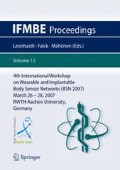Abstract
For about 20 years, Cochlear Implants have successfully restored hearing in postlingual deaf or helped to acquire auditory communication in prelingual deaf patients. However, only in recent years Cochlear Implant manufacturers have implemented stimulating and recording protocols for evoked compound action potentials in order to assess auditory nerve function in relation to the implanted device. Along with the principles of stimulation and recording of TECAPs, two cases are presented which highlight their diagnostic value as well as their limitations. While the pooled data obtained from patients are yet too variable to serve as a predictor for individual stimulation strategies, TECAPs are highly useful in intraindividual follow-up of patients in whom Cochlear Implant stimulation currents may vary even after years and who require re-adjustment according to objectively registered neural responses.
Access this chapter
Tax calculation will be finalised at checkout
Purchases are for personal use only
Preview
Unable to display preview. Download preview PDF.
References
Moller AR (2006) History of cochlear implants and auditory brainstem implants. Adv Otorhinolaryngol 64:1–10
Geers AE (2006) Factors influencing spoken language outcomes in children following early cochlear implantation. Adv Otorhinolaryngol 64:50–65
Harrison RV, Gordon KA, Mount RJ (2005) Is there a critical period for cochlear implantation in congenitally deaf children? Analyses of hearing and speech perception performance after implantation. Dev Psychobiol 46(3):252–61
Papsin BC (2005) Cochlear implantation in children with anomalous cochleovestibular anatomy. Laryngoscope 115(1 Pt 2 Suppl 106):1–26
Zeng FG (2004) Trends in cochlear implants. Trends Amplif 8(1):1–34
Mylanus EA, Rotteveel LJ, Leeuw RL (2004) Congenital malformation of the inner ear and pediatric cochlear implantation. Otol Neurotol 25(3):308–17
Incesulu A, Kocaturk S, Vural M (2004) Cochlear implantation in chronic otitis media. J Laryngol Otol 118(1):3–7
El-Kashlan HK, Telian SA (2004) Cochlear implantation in the chronically diseased ear. Curr Opin Otolaryngol Head Neck Surg 12(5):384–6
Das S, Buchman CA (2005) Bilateral cochlear implantation: current concepts. Curr Opin Otolaryngol Head Neck Surg 13(5):290–3
McDermott HJ (2004) Music perception with cochlear implants: a review. Trends Amplif 8(2):49–82
Roland PS, Wright CG (2006) Surgical aspects of cochlear implantation: mechanisms of insertional trauma. Adv Otorhinolaryngol 64:11–30
Briggs RJ, Tykocinski M, Stidham K, Roberson JB (2005) Cochleostomy site: implications for electrode placement and hearing preservation. Acta Otolaryngol 125(8):870–6
Callanan V, Poje C (2004) Cochlear implantation and meningitis. Int J Pediatr Otorhinolaryngol 68(5):545–50
Cafarelli Dees D, Dillier N, Lai WK, von Wallenberg E, van Dijk B, Akdas F, Aksit M, Batman C, Beynon A, Burdo S, Chanal JM, Collet L, Conway M, Coudert C, Craddock L, Cullington H, Deggouj N, Fraysse B, Grabel S, Kiefer J, Kiss JG, Lenarz T, Mair A, Maune S, Muller-Deile J, Piron JP, Razza S, Tasche C, Thai-Van H, Toth F, Truy E, Uziel A, Smoorenburg GF (2005) Normative findings of electrically evoked compound action potential measurements using the neural response telemetry of the Nucleus CI24M cochlear implant system. Audiol Neurootol 10(2):105–16
Dillier N, Lai WK, Almqvist B, Frohne C, Muller-Deile J, Stecker M, von Wallenberg E (2002) Measurement of the electrically evoked compound action potential via a neural response telemetry system. Ann Otol Rhinol Laryngol 111(5 Pt 1):407–14
Gillespie LN, Shepherd RK (2005) Clinical application of neurotrophic factors: the potential for primary auditory neuron protection. Eur J Neurosci 22(9):2123–33
Author information
Authors and Affiliations
Corresponding author
Editor information
Editors and Affiliations
Rights and permissions
Copyright information
© 2007 International Federation for Medical and Biological Engineering
About this paper
Cite this paper
Ilgner, J., Döring, W.H., Westhofen, M. (2007). The Use of Telemetry-Evoked Compound Action Potentials (TECAP) in Cochlear Implantation. In: Leonhardt, S., Falck, T., Mähönen, P. (eds) 4th International Workshop on Wearable and Implantable Body Sensor Networks (BSN 2007). IFMBE Proceedings, vol 13. Springer, Berlin, Heidelberg. https://doi.org/10.1007/978-3-540-70994-7_29
Download citation
DOI: https://doi.org/10.1007/978-3-540-70994-7_29
Publisher Name: Springer, Berlin, Heidelberg
Print ISBN: 978-3-540-70993-0
Online ISBN: 978-3-540-70994-7
eBook Packages: EngineeringEngineering (R0)

